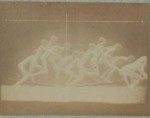
Ballet: What is the Matter?
by Lynn Matluck Brooks
Ballet Matters, Jennifer Fisher’s* memoir-as-ethnographic study, sometimes spills into provocative philosophical rumination and witty spiritual confession. In the process, the author investigates the matter of ballet, as well as offering her take on what seems to be the matter with it. As someone who has fallen increasingly in love with ballet as I’ve moved through my career, I found it an enormous relief to encounter Fisher’s informed, grounded, and daringly positive take on an art that has been dismissed as elitist, patriarchal, Eurocentric, dated, and even dead. This isn’t my take on it, nor is it Fisher’s.
Growing up in middle-class 1950s/60s middle America, Fisher was trotted off, like many others of that age and situation, to ballet classes. For her, it became more than a superficial little-girl nicety; instead, ballet infused, she writes, “the story I told about myself” (pp. 20–21). While she experienced other forms of dancing as well—tap, acrobatics, ballroom, rock ‘n’ roll, modern dance, jazz, and more—she found her home in ballet’s technique, aimed at unattainable perfection, demanding precision, and requiring mindful discipline and “grit” (pp. 86–88). Embodying ballet and watching it with empathic attention taught Fisher “about life and how to launch yourself into it” (p. 1). As a bright girl who never quite felt that she “fit in” (who did?), ballet became Fisher’s haven, the practice that excited and engaged her, and also the place where strong women led schools and classes, unfolded professional careers, and spoke or wrote articulately about their bodies, experiences, and lives (pp. 35, 41–42).
As ballet took over her body and curiosity, Fisher devoured books about the ballet artists who inspired her. Ah yes, I did that, too. Anna Pavlova, though deceased before Fisher was born, became a special “friend” (pp. 54–60) to the young ballet student, who read the ballerina’s memoir, pored over images of the delicate but steely-souled Russian prima, and aspired to follow in her path. Fisher’s hungry dance-reading taught her history, sociology, and mythology, while studio experiences gave her daily discipline and the recognition that aspirations sometimes must be redirected. When no roving impresario scooped Fisher out of her hometown studio to tour with his exotic company (her childhood fantasy), she squarely faced that reality, choosing to major in theater, not dance, in college. She underwent the post-dance crises of loss and reorientation that many devotees, bereft of a lifelong practice, know, but she eventually discovered that her talent as a writer, nurtured through the text-centered study of drama, could get her work. Through a series of job hops, she moved into the land of cultural criticism (beginning with TV), where she developed her eye for detail and for a story, her capacity to draw out the best in an interview, the editorial skills to write with clarity and precision, and the habit of meeting deadlines.
Fortunately for those of us who appreciate Fisher’s sharp eye and wit as a dance writer, she was drawn back to the world of ballet by a 1988 vacation tour to Soviet-dominated Eastern Europe and Russia, where her itinerary allowed her privileged access to conservatories, backstages, and performances in Estonia, Latvia, Ukraine, and—the Holy Grail of ballet—Leningrad (St. Petersburg), Russia. I absorbed Fisher’s deepening ecstasy as she and a balletomane friend observed class after class, met with teachers and dancers, and took in every available performance. Glued to her text, I thrilled vicariously to her descriptions and hungrily studied each photo documenting the trip. It was at the Maryinsky that she thrilled to the very palpable experience of the archive (I know that excitement, too!). At the theater’s museum, she found the detritus of dance history—costumes, portraits, programs, scores—an enticement that continued to draw her as she moved into dance graduate work and, eventually, university teaching, dance criticism, and academic writing. While leaving behind her ballerina fantasy, she came full circle to her earlier dance dreams: “There are failed dancers who cry over it, but there are also women whose encounters with ballet make them strong enough to keep searching for a career. Sometimes, an initial love of ballet doesn’t need to be lost” (p. 128).
The final section of her memoir is a hymn to ballet as spiritual practice. Noting the Foucauldian accusations of ballet as punishment of female bodies, Fisher counters that for her, as both child novice and adult professor, ballet’s rules “had a rational purpose. Rules in the name of art could lead you to a different place than Foucault’s prison or insane asylum” (p. 153). They led Fisher to a deep appreciation of the rituals and sanctity of the studio, the rehearsal room, and the theater, confirming, through personal sorrows and world cataclysms, life’s meaning and aspiration. As evidence, Fisher offers astute and vibrant analyses of several ballets: the “holy ballet” (p. 168) Giselle (chor. Coralli, Perrot, Petipa); La Bayadere (Petipa), a “numinous display” (p. 175); Serenade (Balanchine), “a kind of code,… a prayer” (p. 176); and the “ceremonial mourning” (p. 178) of Dancing on the Front Porch of Heaven (Dove). Her closing commentary exalts Alonzo King, artistic director of LINES Ballet, whose works allow Fisher to “slip … into spiritual, ecstatic mode” (p. 180), and whose commentary “never shies away from delving into the big picture philosophically” (p. 183).
Fisher graciously acknowledges the scholars, especially Cynthia Novack and Brenda Dixon Gottschild, who led her to connect her ballet passion with teaching, research, and writing. Surely Fisher, too, will serve as this kind of touchstone for new scholarly visions and deep-dives into dance-as-meaning for upcoming generations of dance students and researchers.
* When I was serving as co-editor of Dance Chronicle, I had the pleasure of editing Jennifer Fisher’s writing for that journal. We have also met at conferences.
Jennifer Fisher, Ballet Matters: A Cultural Memoir of Dance Dreams and Empowering Realities. Jefferson, NC: McFarland & Co., Inc., 2019. 196 pp.
By Lynn Matluck Brooks
June 22, 2019










